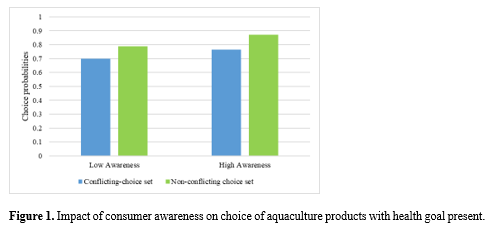CONSUME IT, YET UNAWARE? THE INFLUENCE OF A HEALTH GOAL ON CHOICE OF AQUACULTURE PRODUCTS AMONG BRAZILIAN CONSUMERS
Acknowledgements
This work has been funded by the Danish Agency for Science and Higher Education, Grant Nr. 8073-00029B, 2019-2020.
Introduction
Brazil is one of the world’s largest fish producer with an extensive maritime coast on the Atlantic Ocean and a great quantity of rivers, lakes and barrages. Fishing represents an important source of income for Brazil and the socio-economic characteristics of the fisheries are very much diverse, due to the coast geographic dimension as well as due to the different culture in the different geographical regions in terms of fish ing and fish farming
. Even though Brazil has a great potential in terms of seafood, Brazilians consume very little fish in general, accounting for only 9.02 kg/per capita/year where only 2.45 g/per capita/day of protein supply comes from fish and seafood
. This consumption differs depending on the region with northern states consuming more and southern ones consuming less fish. Underlying reasons of the low fish consumption mentioned are awareness , price, taste , and health issues
(Baptista, Rodrigues, & Sant’Ana, 2020; Maciel et al., 2013; Mitterer-Daltoé, Carrillo, Queiroz, Fiszman, & Varela, 2013)
. To be able to develop suitable strategies to increase consumers’ consumption of fish, a better understanding of consumers ’ fish choices across different Brazilian regions is of key importance. Therefore, in this study we account for the role of a health goal and awareness on the aquaculture product choice, and its relationship with taste and price in the congruent non-conflicting versus incongruent conflicting choice context.
Materials and methods
An experimental study was designed to examine the role of the health goal and consumer aquaculture product awareness, as well as its relationship with taste and price, in the context where all available choice-set options do not conflict with the health goal versus when all the options in the choice-set conflict with the health goal, taking into account different Brazilian geographical regions. The congruent actions we re assumed (i.e., healthy - expensive) when the choice-set options do not conflict with the active health goal (i.e., congruent, healthy choice-set), and vice-versa when conflicting-choice set present. It is further as sumed that this effect is moderated by consumers’ aquaculture product awareness that increases (or decreases ) the influence of the health goal contingent on the choice context (non-conflicting vs. conflicting). One thousand three hundred and three participants were randomly assigned to one of the four experimental conditions: 2 goals (health goal vs. control) x 2 choice-sets (non-conflicting vs. conflicting) . The sample was representative of the Brazilian population.
Results
The results from the binary logistic regression showed significant interaction effect between choice-set and consumer aquaculture product awareness when health goal present (β = -0.867, Wald = 6.416, p = 0.011) , while region as a covariate was not significant (p = 0.732). This indicated that when health goal present with non-conflicting choice more congruent action s occurred (healthy - expensive) among those individuals who were high in awareness regarding Brazilian aquaculture then those individuals that were low in awareness, opting to choose more often higher-priced product options, see Figure 1.
Conclusions
T he impact of health information on consumers’ choice of aquaculture product should be carefully deliberated in both healthy and unhealthy choice contexts. This is particularly important as health information can be efficiently reinforced through taste establishing healthier food choices, and this is particularly true among consumers who possess higher levels of product awareness. On contrary, this can fail in the unhealthy choice contexts where this information could still increase consumers’ product choice .
References
Baptista, R. C., Rodrigues, H., & Sant’Ana, A. S. (2020). Consumption, knowledge, and food safety practices of Brazilian seafood consumers. Food Research International, 132, 109084. doi:https://doi.org/10.1016/j.foodres.2020.109084
FAO. (2020). The State of World Fisheries and Aquaculture 2020. . Retrieved from
FAOSTAT. (2021). FBS: New Food Balances. Retrieved from http://www.fao.org/faostat/en/#data/FBS
Maciel, E. D. S., Savay-da-Silva, L. K., Vasconcelos, J. S., Sonati, J. G., Galvão, J. A., Lima, L. K. F. D., & Oetterer, M. (2013). Relationship between the price of fish and its quality attributes: a study within a community at the University of São Paulo, Brazil. Food Science and Technology, 33(3), 451-456.
Mitterer-Daltoé, M., Carrillo, E., Queiroz, M., Fiszman, S., & Varela, P. (2013). Structural equation modelling and word association as tools for a better understanding of low fish consumption. Food Research International, 52(1), 56-63.
